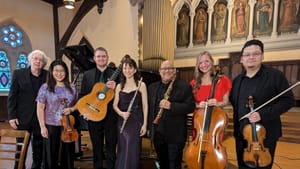Stay in the Loop
BSR publishes on a weekly schedule, with an email newsletter every Wednesday and Thursday morning. There’s no paywall, and subscribing is always free.
Variations beyond Bach
Dolce Suono presents Great Arrangements

The musicians of Dolce Suono have been playing together in varying configurations for two decades, and for Great Arrangements, the second concert of their 20th anniversary season, they presented four works: two well-known, two less familiar, but all arresting and impeccably played. The premise that united them—aside from virtuosic parts for each ensemble member—was an interesting one: each composition was heard in an arrangement differing from how the composer wrote it.
In her remarks, artistic director (and wonderful flutist) Mimi Stillman noted with a sly smile that the repertoire for her instrument is much smaller than that for others (like string players), and so she’s become accustomed to playing works written for other instruments. She also noted that before recordings, people had to create arrangements in order to hear favorite compositions or composers, so they were a sort of homage and a way of keeping the music alive and accessible.
Starting with Mozart
The full-house concert was held in the lovely space of Trinity at 22nd, an Episcopal church near Rittenhouse Square with a barrel-vaulted ceiling and expanses of wood that created a warm and welcoming acoustic. First on the program was Mozart’s Quintet in E-flat Major, a three-movement work written in 1784 that Mozart considered one of his best. He was right.
The arrangement heard here was first played by Dolce Suono in 2017, and the clarinet part is original to the work. Not surprisingly, Ricardo Morales (first chair of the Philadelphia Orchestra) shone throughout. String parts—Che-Hung Chen on viola and Arlen Hlusko on cello—were drawn from a 19th-century version by Ernest Nauman, while Stillman played what was originally written for oboe. There were some dazzling conversational instrumental handoffs and duets, often humorous. And this being Mozart, the piano part was scintillatingly beautiful. Pianist Charles Abramovic dashed off the sparkling runs and luscious passages with the ease and grace required of a great Mozart interpretation.
Balkan dances and the Baroque
The second work on the program switched to the early 20th century: Seven Balkan Dances by Marko Tajčević (1900-1984), a Serbian composer who was inspired by (and interpreted) folk music. This charming suite of brief dances is one of his most popular works, originally written for solo piano and touching on folk styles from Croatia, Serbia, Macedonia, and Montenegro. The work, ranging from lively, sometimes klezmer-like movements to dramatic dances and lullaby-like sections, was arranged by Abramovic, who spoke about it as part of his heritage. He set it for piano, flute, clarinet, and violin (Amy Oshiro-Morales), and while dramatic keyboard passages undergirded the work, he generously gifted many of its considerable musical pyrotechnics to his three colleagues, who embraced them with flair.
After intermission, there was another quick musical turn, back to the Baroque for selections from the Goldberg Variations of J.S. Bach. This is another work originally written for piano, opening with an aria movement followed by 30 variations, each contrasting in structure, mood, and style. The ensemble played it here in an arrangement by Dmitry Sitkovetsky for string trio: Oshiro-Morales (violin), Chen (viola), and Hlusko (cello). Hlusko spoke about the work, noting that this 90-minute setting has become a staple of the string trio repertoire, one that she and other string players study intensively and love to play. For this concert, they chose to perform the opening aria movement and the first 10 variations. The trio played with virtuosity and musical joy throughout, all three equally matched as the work’s precision and depth were explored and unfolded.
Performing Astor Piazzolla
The concert closed with an instrumental arrangement of three sections from Maria de Buenos Aires, a tango opera by Astor Piazzolla, the composer, bandleader, and bandoneon player best known for his compelling works of nuevo tango. His surrealist (and only) opera tells of a young girl from a poor family lured by the tango to Buenos Aires, where she falls in with bad company, ultimately dying as a sex worker.
The three movements—Tema de Maria (Maria’s Theme), Fuga y misteria (mystery fugue), and Allegro Tangabile—pulsed with lush music, here arranged by Tim Ribchester for flute, clarinet, cello, piano, and guitar, beautifully played by Gideon Whitehead. Dolce Suono premiered Ribchester’s work in 2009, and it was further re-arranged for this concert. As often with Piazzolla (and tango itself), the guitar is also used as a percussion instrument, skillfully woven by Whitehead into the instrumental mix. Channeling the libretto (by Horacio Ferrer), the music is filled with surrealistic overtones, jazz riffs, syncopation, and swinging rhythms. The ensemble’s virtuosity and verve really allowed Piazzolla’s compositional skills to shine. If a program this excellent could have a highlight, this thrilling work might be it.
High spirits
The musicians clearly loved presenting this concert. As they switched in and out to create differing ensembles, it was especially joyful to watch their sensitive communication. While the aptly titled Great Arrangements wasn’t a holiday concert, this varied music compellingly performed was a reminder that beautiful playing and thoughtful programming will lift the spirits just as high as any standard repertoire we’ve come to expect at this time of the year.
What, When, Where
Great Arrangements. Mimi Stillman, flute; Ricardo Morales, clarinet; Amy Oshiro-Morales, violin; Che-Hung Chen, viola; Arlen Hlusko, cello; Charles Abramovic, piano; and Gideon Whitehead, guitar. Dolce Suono Ensemble. December 8, 2024, at Trinity at 22nd, 2212 Spruce Street, Philadelphia. dolcesuono.com.
Accessibility
Trinity at 22nd has four steps leading into the venue; the side-door elevator was not in use for this concert. Once inside, seating is on one level.
Sign up for our newsletter
All of the week's new articles, all in one place. Sign up for the free weekly BSR newsletters, and don't miss a conversation.

 Gail Obenreder
Gail Obenreder